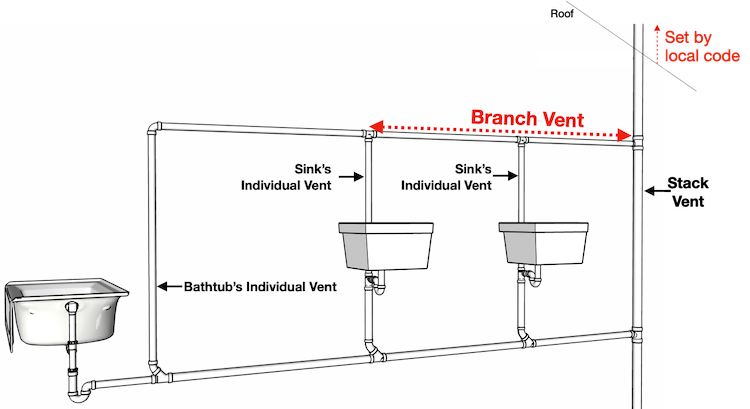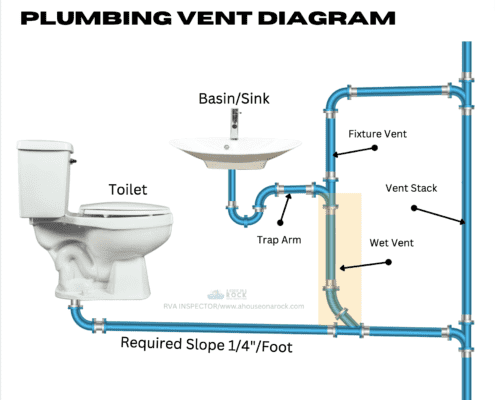The Importance of Proper Ventilation in Your Plumbing System
The Importance of Proper Ventilation in Your Plumbing System
Blog Article
Any individual is bound to have their own thinking involving Essential Plumbing Vent Pipes: Understanding Their Role.

Appropriate air flow in pipes systems is often neglected, yet it is essential for preserving the functionality and safety and security of your home's plumbing. Ventilation assists regulate air pressure, stop the buildup of damaging gases, and make sure the effective removal of waste. In this overview, we will certainly check out the value of correct pipes ventilation, just how it functions, and the advantages it offers your plumbing system.
Comprehending Ventilation in Plumbing
Ventilation in plumbing describes the network of pipes that permit air to stream through the drainage system. These vents offer numerous purposes, including controling air pressure within the pipelines, avoiding drain gases from getting in the home, and helping in the smooth circulation of wastewater.
How Ventilation Works in Pipes Solutions
Atmospheric Pressure Policy
Correct ventilation preserves well balanced atmospheric pressure within the plumbing system. When water moves via pipes, it displaces air. Without adequate air flow, this variation can produce unfavorable stress, leading to slow down drains pipes or siphoning of water from catches, which can cause unpleasant smells to leak into the home.
Stopping Drain Gas Buildup
Among one of the most vital features of pipes vents is to stop drain gases, such as methane and hydrogen sulfide, from building up within the home. These gases can pose major health risks and are extremely flammable. Vent pipelines permit these gases to get away safely outside.
Helping in Waste Removal
Ventilation assists in the effective elimination of wastewater by avoiding airlocks in the drainage system. When air can move openly through the vents, it allows water and waste to stream smoothly through the pipelines, reducing the danger of clogs and backups.
Kinds Of Plumbing Vents
Key Heap Vent
The major pile vent, additionally called the vent pile, is the main vent in a pipes system. It prolongs from the main drainpipe line up through the roof covering, enabling gases to leave and fresh air to go into the system.
Branch Vent
Branch vents link to the primary pile vent and serve private components, such as sinks, bathrooms, and showers. These vents make sure that each fixture has sufficient air flow to function effectively.
Air Admission Valve (AAV).
An Air Admittance Valve (AAV) is a one-way valve that allows air to get in the pipes system without the requirement for a conventional vent pipeline expanding with the roofing system. AAVs are typically made use of in remodellings or areas where mounting a typical air vent is impractical.
Signs of Poor Ventilation in Plumbing.
Slow Draining Fixtures.
If your sinks, bathtubs, or toilets are draining gradually, maybe an indication of bad air flow. Inadequate air flow can create a vacuum cleaner impact, making it challenging for water to drain pipes effectively.
Gurgling Appears.
Gurgling audios coming from drains are often an outcome of air being sucked with water traps due to unfavorable pressure in the pipelines. This is a clear indication of insufficient ventilation.
Undesirable Smells.
Sewage system odors inside your home are a red flag that your pipes system is not appropriately aerated. This might imply that sewage system gases are not being adequately vented outside, leading to possibly dangerous conditions.
Typical Air Flow Blunders.
Insufficient Vent Sizing.
Using small air vent pipelines can bring about inadequate air flow and stress discrepancies in the system. It's vital to use vents that meet the specific requirements of your plumbing system.
Improper Vent Placement.
Placing vents also far from the components they serve can decrease their effectiveness. Proper positioning guarantees that air can stream freely and successfully with the system.
Disregarding Code Requirements.
Building regulations offer particular standards for pipes ventilation. Neglecting these codes can lead to a system that fails to operate appropriately and might bring about pricey fixings or carcinogen.
Benefits of Appropriate Ventilation.
Enhanced System Effectiveness.
Correctly aerated pipes systems operate a lot more successfully, with fewer obstructions, faster draining pipes, and much less pressure on the pipelines. This efficiency prolongs the life expectancy of the plumbing system.
Improved Air Top Quality.
By stopping sewer gases from entering your home, correct ventilation adds to better indoor air quality, making your living atmosphere healthier and more comfortable.
Preventing Water Damages.
Sufficient ventilation aids prevent water from being siphoned out of catches, which can bring about drain gases going into the home and causing water damage with time.
Steps to Ensure Correct Ventilation.
Consulting Pipes Codes.
Constantly get in touch with regional pipes codes when making or changing your pipes system. These codes give the required guidelines for correct venting and ensure your system meets safety requirements.
Routine Assessment and Upkeep.
Routine evaluations can help recognize prospective air flow issues prior to they end up being major issues. Maintenance jobs, such as cleansing air vent pipelines and looking for blockages, are crucial for keeping the system in good working order.
Specialist Setup.
For new installations or major modifications, it's wise to work with a specialist plumbing technician. They have the know-how to make sure the ventilation system is correctly made and set up according to code.
Final thought.
Proper air flow is a vital element of any plumbing system, guaranteeing that it functions efficiently and safely. By recognizing the value of ventilation, recognizing the indicators of poor air flow, and taking actions to maintain your system, you can prevent pricey problems and safeguard your home's air quality.
4 Things You Should Know About Your Plumbing Vents
What Plumbing Vents Are
Also called a vent stack, a plumbing vent is a vertical pipe attached to your drain line that runs through your roof. The plumbing vent pipe, or plumbing air vent, removes gas and odors from your plumbing system and allows fresh air to enter the pipes, helping the water to flow out of the drain pipes.
What Plumbing Vents Do
Plumbing vents have two basic functions. One of which is to allow unpleasant smelling wastewater and sewer gasses to escape your plumbing system instead of entering your home. Plumbing vent pipes are typically located on roofs, away from windows, to ensure the fumes exit the home completely.
The other function of the plumbing vent is to move fresh air into your plumbing system. This helps move water through every plumbing fixture in your house, like toilets and sink drains. Think of the way in which you need to let a little air into the bottle as you pour soda in order to make the drink flow smoothly.
Different Types of Plumbing Vents
True vent: This is the most common vent option. In simplest terms, a true vent is a vertical pipe attached to your drain line that exits through the roof. They often function as the main vent that other fixtures can connect to. Re-vent pipe or auxiliary vent: Attached to the drain line near specific plumbing fixtures, re-vent pipes run up and over to connect to the main vent. Common vent: Two plumbing fixtures installed on opposite sides of a wall are typically tied into the vent stack using something known as a sanitary cross. Wet vent: This venting option operates as a drain pipe and a vent at the same time. Wet vent drainage systems drain water from one fixture while venting the air from another. Although they’ve been used for over 100 years, wet vent systems have only recently been added to the plumbing code in many areas. If you’re planning on installing one in a bathroom remodel, make sure you check your local code prior to construction. Loop vent: For free-standing fixtures like kitchen island sinks, loop vents are ideal. These vent pipes run under the floor, rise from the P-trap, and create a loop inside the cabinet sink. Air admittance valve: An AAV is a one-way mechanical valve typically installed at the site of the plumbing fixture. AAVs allow venting to occur without having to tie into a larger venting system. They’re ideal for venting fixtures where you aren’t able to easily connect to an existing vent system. Common Plumbing Vent Issues
Although vent pipes typically don’t have water flowing through them, they’re still subject to many typical plumbing issues. For example, clogs are one of the most common problems associated with sewer vent pipes. If your vent pipe gets clogged, all of your plumbing fixtures tied into the vent stack will be affected.
A sink with a slow drain that bubbles and gurgles or a strong sewage smell around your toilet are both indicators that your toilet vent pipe is clogged. Because most vent pipes exit through the roof, old leaves, twigs or even a bird’s nest could be clogging the pipe.
Clogs in your vent pipe system cause a buildup of negative pressure, meaning that water won’t be able to flow out of your home very well. It’s similar to putting your finger over the opening of a straw to trap water inside. When you remove your finger, the water is able to flow out of the straw.
If you suspect you have any blockage in your vent, make sure you have a professional come examine the situation. Left unchecked, a blocked air vent can lead to other costly repairs, like leaks and sediment buildup.
Under Pressure
Pipe vents are essential aspects of a home’s plumbing system. Owning a home means learning about all sorts of things you never put much thought into before. But by understanding as much as you can about the important systems of your home, you can keep those budgets intact and those anxiety levels low.
https://www.homeserve.com/en-us/blog/home-improvement/plumbing-vents/

I was made aware of that article on What Is A Plumbing Vent & How Do They Work? from an acquaintance on our other blog. Sharing is caring. Helping others is fun. I thank you for reading our article about The Upsides of Proper Ventilation in Plumbing Design.
Click For More Info Report this page